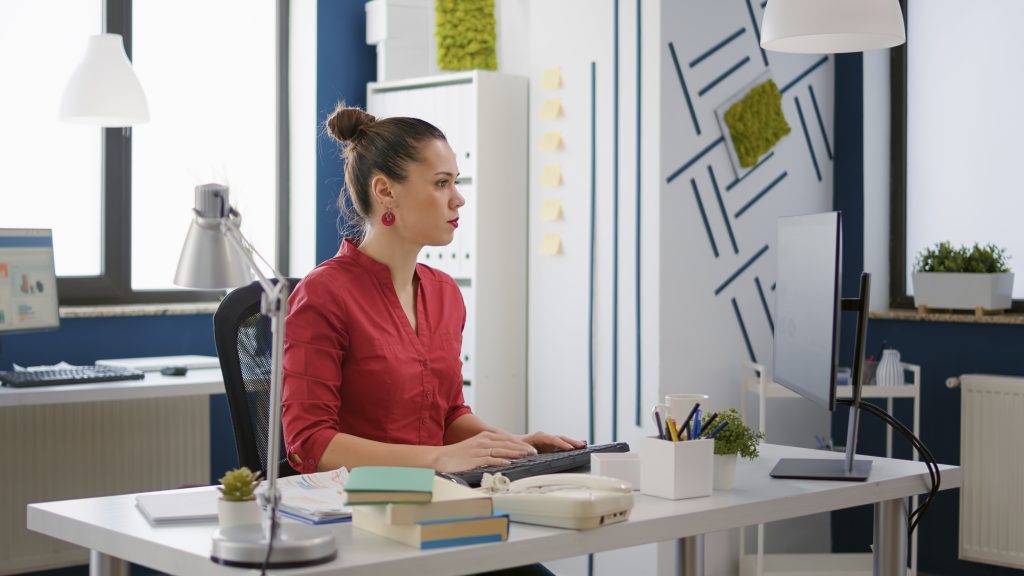In today’s fast-paced world, having an efficient workspace is crucial for maximizing productivity. Whether you’re working from home, in an office, or in a hybrid environment, the design and organization of your workspace can make all the difference in how productive and focused you are throughout the day. With the rise of remote work and flexible schedules, the need to optimize workspaces has never been more important.
In this article, we’ll explore the current trends in workspace efficiency, the key elements that contribute to a productive environment, and actionable tips to help you create the perfect workspace tailored to your needs.

The Importance of an Efficient Workspace
Having a well-organized, comfortable workspace goes beyond just aesthetics—it can significantly impact your ability to focus, your mental well-being, and your overall performance at work. Research has shown that an efficient workspace can improve productivity, reduce stress, and increase job satisfaction. According to a 2024 study by the Harvard Business Review, employees with well-designed workspaces experience 25% higher productivity and greater engagement levels.
In 2025, it’s not just about creating a space that looks nice—it’s about designing a workspace that enhances cognitive function, reduces distractions, and supports your workflow.
Current Trends Shaping Workspace Design in 2025
As we move into 2025, several emerging trends are reshaping how people approach workspace efficiency. Let’s dive into some of the latest trends that can help you boost productivity and optimize your workspace.
1. Ergonomics and Comfort: The Foundation of Productivity
With more people working from home, the importance of ergonomic furniture and equipment has become even more pronounced. An ergonomic chair, adjustable desk, and properly positioned computer monitor can significantly reduce physical discomfort and the risk of injury, which in turn improves focus and efficiency. According to the Occupational Safety and Health Administration (OSHA), poor posture and ergonomic issues can lead to fatigue, back pain, and other health problems that ultimately reduce productivity.
- What to Include:
- Ergonomic Chairs: Look for chairs that support your spine’s natural curve and allow for adjustable height and armrests.
- Standing Desks: Adjustable desks that allow you to alternate between sitting and standing can help improve posture and reduce discomfort during long work hours.
- Keyboard and Mouse: Invest in ergonomically designed keyboards and mice to prevent wrist strain.
2. Decluttered Spaces: Minimalism for Maximum Focus
A cluttered workspace can negatively affect your ability to concentrate and process information. In fact, studies have shown that clutter can lead to increased stress levels and hinder cognitive performance. To enhance your productivity, it’s important to declutter your workspace regularly and adopt a minimalist approach.
- Benefits:
- Less Distraction: A clean, organized workspace reduces visual distractions, helping you stay focused on your tasks.
- Improved Efficiency: When everything has its place, you spend less time searching for items and more time working.
- Tips:
- Use organizational tools like drawer organizers, cable management systems, and wall-mounted shelves to keep essential items within reach.
- Make use of digital tools to reduce physical paperwork and store files electronically.
3. Smart Technology Integration
Technology continues to play a huge role in increasing workspace efficiency. In 2025, smart technologies are helping people streamline tasks, reduce distractions, and automate repetitive work. From smart lighting and climate control to AI-powered assistants, integrating the right technology into your workspace can drastically improve your productivity.
- Examples of Smart Technology:
- Smart Lighting: Adjustable lighting systems like Philips Hue can help set the right mood and improve focus by adjusting the color temperature throughout the day.
- Voice Assistants: Tools like Alexa, Google Assistant, and Siri can help with setting reminders, managing calendars, and answering quick questions hands-free, leaving you more time to focus on important tasks.
- AI Tools: AI-based software such as Grammarly, Otter.ai, and project management tools like Monday.com or Asana can help automate tasks and increase collaboration.
4. Biophilic Design: Bringing Nature into the Workspace
Biophilic design, which involves incorporating natural elements into the workspace, has become a major trend in 2025. The presence of plants, natural light, and outdoor elements has been proven to improve mood, reduce stress, and boost creativity. According to a 2023 study by Human Spaces, workers who have access to natural elements in their workspace are 15% more productive and 6% more engaged.
- How to Incorporate Biophilic Design:
- House Plants: Add a few low-maintenance plants like succulents or ferns to purify the air and bring a touch of nature to your space.
- Natural Light: If possible, place your desk near a window to take advantage of natural light, which helps regulate your circadian rhythm and improves focus.
- Wooden Furniture: Incorporate wood or stone textures into your workspace, which has been shown to create a calming and soothing atmosphere.
5. Flexible and Adaptable Spaces
As remote work becomes more common, many young professionals are embracing the idea of flexible workspaces that can adapt to their changing needs. This flexibility allows you to switch between different tasks, such as brainstorming, deep focus, or video calls, without having to leave the room.
- Benefits:
- Increased Productivity: A versatile workspace lets you quickly shift between activities, whether it’s sitting at a desk for deep focus or standing for creative thinking.
- Collaboration-Friendly: Flexible spaces with collaborative tools help you work with teams without leaving the comfort of your home.
- What to Include:
- Modular Furniture: Invest in furniture that can be easily moved or reconfigured for different tasks.
- Multi-Functional Spaces: Consider creating zones in your workspace that cater to different activities—like a quiet corner for focused work and a more relaxed area for meetings.
6. Personalization: Tailoring Your Space to Your Preferences
Personalization is another growing trend. An increasing number of young professionals are transforming their workspaces into environments that reflect their personality and preferences. Customizing your workspace can make it feel more comfortable, inspiring, and conducive to productive work.
- What to Personalize:
- Wall Art: Choose artwork that motivates you, whether it’s a favorite quote, nature scenes, or abstract art.
- Color Palette: Use colors that are known to enhance focus and creativity, such as blues and greens for calming effects.
- Inspiring Items: Place meaningful objects on your desk, such as personal photos, souvenirs, or items that inspire you.
7. Healthy Workspace Habits
An efficient workspace isn’t just about the physical setup; it’s also about promoting healthy work habits. Incorporating strategies to improve posture, take regular breaks, and manage stress can significantly boost productivity.
- Healthy Workspace Tips:
- Take Regular Breaks: Use the Pomodoro Technique or set timers to remind yourself to take short breaks throughout the day.
- Posture and Movement: Practice good posture and use standing desks or sit-stand desk converters to avoid the negative effects of sitting all day.
- Hydration and Snacks: Keep a water bottle nearby to stay hydrated, and opt for healthy snacks that help maintain your energy levels.
Conclusion
Creating an efficient workspace in 2025 is about more than just aesthetics—it’s about fostering an environment that promotes productivity, reduces stress, and enhances well-being. By integrating ergonomic furniture, incorporating smart technology, embracing biophilic design, and personalizing your space, you can create a workspace that supports your professional and personal growth. Whether you’re working from home, in an office, or in a hybrid setup, an optimized workspace is the key to boosting your productivity and work-life balance.
Implementing these strategies will help you create an environment that supports your success and makes work feel less like a chore. Start by making small changes today, and watch your productivity soar.
Reference
- The Role of Workplace Design in Enhancing Employee Satisfaction: https://blogs.psico-smart.com
- The Magic Brush Of Biophilic Design-Which Biophilic Design Elements Are Most Effective In Improving Employee Well-being? https://workspaceshow.co.u
- Why Biophilic Design Is Crucial in the Workplace and Beyond, https://www.gensler.com









